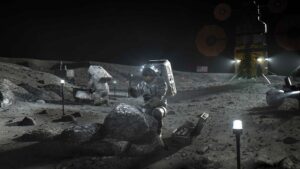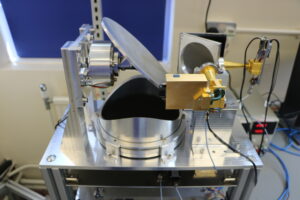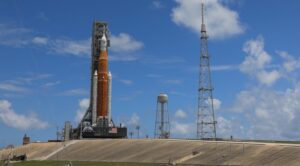Goodyear joins Lockheed Martin to commercialize lunar mobility
Thursday, 21 July 2022 01:53 The Goodyear Tire and Rubber Company supplied essential products for NASA's Apollo program, including the Apollo 11 mission which landed on the Moon 53 years ago today. The company will continue that tradition-focusing on lunar vehicle tires-by joining Lockheed Martin in its development of a lunar mobility vehicle.
Since Apollo, Goodyear continued innovating alongside NASA to advance desig
The Goodyear Tire and Rubber Company supplied essential products for NASA's Apollo program, including the Apollo 11 mission which landed on the Moon 53 years ago today. The company will continue that tradition-focusing on lunar vehicle tires-by joining Lockheed Martin in its development of a lunar mobility vehicle.
Since Apollo, Goodyear continued innovating alongside NASA to advance desig Futuristic Space Habitat lands at Institut Auf Dem Rosenberg
Thursday, 21 July 2022 01:53 Pioneering Swiss boarding school Institut auf dem Rosenberg unveiled today - the anniversary of Neil Armstrong and Buzz Aldrin's famous moon landing - the Rosenberg Space Habitat (RSH), which will serve as an experimental lab for students to explore and actively shape the future of humanity on our planet and beyond. Co-created by Rosenberg students and SAGA Space Architects with sustainable mate
Pioneering Swiss boarding school Institut auf dem Rosenberg unveiled today - the anniversary of Neil Armstrong and Buzz Aldrin's famous moon landing - the Rosenberg Space Habitat (RSH), which will serve as an experimental lab for students to explore and actively shape the future of humanity on our planet and beyond. Co-created by Rosenberg students and SAGA Space Architects with sustainable mate Unequal siblings: Ius and Tithonium Chasma
Thursday, 21 July 2022 01:53 When NASA's Mariner 9 spacecraft reached Mars more than 50 years ago at the end of 1971 and began to explore the planet from orbit, there was initially great disappointment at the control centre: virtually nothing could be seen in the images sent to Earth. At that time, a global dust storm was raging on Mars, which made it impossible to see the surface. Only the peaks of the highest volcanoes st
When NASA's Mariner 9 spacecraft reached Mars more than 50 years ago at the end of 1971 and began to explore the planet from orbit, there was initially great disappointment at the control centre: virtually nothing could be seen in the images sent to Earth. At that time, a global dust storm was raging on Mars, which made it impossible to see the surface. Only the peaks of the highest volcanoes st When Mars throws you a curveball Sol 3539-3540
Thursday, 21 July 2022 01:53 The rover has been making its way along the "Bolivar" ridge, dodging small boulders and rocks that have apparently eroded off the hillside as seen in the above engineering camera image. Unfortunately, due to the complex terrain our last drive ended about 11 meters short of its anticipated location.
Because of the unexpected rover heading, the antenna we usually use to uplink plans directly
The rover has been making its way along the "Bolivar" ridge, dodging small boulders and rocks that have apparently eroded off the hillside as seen in the above engineering camera image. Unfortunately, due to the complex terrain our last drive ended about 11 meters short of its anticipated location.
Because of the unexpected rover heading, the antenna we usually use to uplink plans directly A New Method to Detect Exoplanets
Thursday, 21 July 2022 01:53 In recent years, a large number of exoplanets have been found around single 'normal' stars. New research shows that there may be exceptions to this trend. Researchers from the Autonomous University of Nuevo Leon (UANL), the National Autonomous University of Mexico (UNAM), and New York University Abu Dhabi suggest a new way of detecting dim bodies, including planets, orbiting exotic binary stars
In recent years, a large number of exoplanets have been found around single 'normal' stars. New research shows that there may be exceptions to this trend. Researchers from the Autonomous University of Nuevo Leon (UANL), the National Autonomous University of Mexico (UNAM), and New York University Abu Dhabi suggest a new way of detecting dim bodies, including planets, orbiting exotic binary stars Webb telescope may have already found most distant known galaxy
Thursday, 21 July 2022 01:53 Just a week after its first images were shown to the world, the James Webb Space Telescope may have found a galaxy that existed 13.5 billion years ago, a scientist who analyzed the data said Wednesday.
Known as GLASS-z13, the galaxy dates back to 300 million years after the Big Bang, about 100 million years earlier than anything previously identified, Rohan Naidu of the Harvard Center for As
Just a week after its first images were shown to the world, the James Webb Space Telescope may have found a galaxy that existed 13.5 billion years ago, a scientist who analyzed the data said Wednesday.
Known as GLASS-z13, the galaxy dates back to 300 million years after the Big Bang, about 100 million years earlier than anything previously identified, Rohan Naidu of the Harvard Center for As Hey Siri: How Much Does This Galaxy Cluster Weigh
Thursday, 21 July 2022 01:53 It's been nearly a century since astronomer Fritz Zwicky first calculated the mass of the Coma Cluster, a dense collection of almost 1,000 galaxies located in the nearby universe. But estimating the mass of something so huge and dense, not to mention 320 million light-years away, has its share of problems - then and now. Zwicky's initial measurements, and the many made since, are plagued by sour
It's been nearly a century since astronomer Fritz Zwicky first calculated the mass of the Coma Cluster, a dense collection of almost 1,000 galaxies located in the nearby universe. But estimating the mass of something so huge and dense, not to mention 320 million light-years away, has its share of problems - then and now. Zwicky's initial measurements, and the many made since, are plagued by sour Gemini's GHOST captures exquisite first light observations of chemically rich star
Thursday, 21 July 2022 01:53 Gemini South, one of the world's most productive and powerful optical-infrared telescopes, received a major capability boost with the successful installation of a new high-resolution spectrograph called GHOST constructed by an international consortium. This cutting-edge scientific instrument will expand our understanding of the earliest stars, the chemical fingerprints of distant planetary syste
Gemini South, one of the world's most productive and powerful optical-infrared telescopes, received a major capability boost with the successful installation of a new high-resolution spectrograph called GHOST constructed by an international consortium. This cutting-edge scientific instrument will expand our understanding of the earliest stars, the chemical fingerprints of distant planetary syste BlueWalker 3 test satellite fully assembled and shipped
Thursday, 21 July 2022 01:53 AST SpaceMobile, Inc. (NASDAQ: ASTS) reports that its BlueWalker 3 test satellite has been fully assembled and left its Midland, TX headquarters and manufacturing facility.
Over the next few weeks, BlueWalker 3 will be undergoing final environmental testing at an off-site facility in California, which will provide flight data to be used during the launch at Cape Canaveral. Following this a
AST SpaceMobile, Inc. (NASDAQ: ASTS) reports that its BlueWalker 3 test satellite has been fully assembled and left its Midland, TX headquarters and manufacturing facility.
Over the next few weeks, BlueWalker 3 will be undergoing final environmental testing at an off-site facility in California, which will provide flight data to be used during the launch at Cape Canaveral. Following this a NASA authorization included in CHIPS Act
Wednesday, 20 July 2022 22:22
The Senate is moving forward with a revised version of a NASA authorization bill that formally authorizes the agency’s Artemis lunar exploration effort and extends operations of the International Space Station.
The post NASA authorization included in CHIPS Act appeared first on SpaceNews.
Spire adding microwave sounders to improve weather forecasts
Wednesday, 20 July 2022 20:44
Spire Global said July 20 it plans to improve its weather forecast services by fitting future smallsats in its fleet with microwave sounders from RAL Space, the British government’s national laboratory.
NASA sets late August and early September launch dates for Artemis 1
Wednesday, 20 July 2022 19:23
NASA has reserved three days in late August and early September for the first launch of its Space Launch System rocket to send the Orion spacecraft to orbit around the moon and back.
Assembling the first global map of lunar hydrogen
Wednesday, 20 July 2022 18:27
Using data collected over two decades ago, scientists from the Johns Hopkins Applied Physics Laboratory (APL) in Laurel, Maryland, have compiled the first complete map of hydrogen abundances on the Moon's surface. The map identifies two types of lunar materials containing enhanced hydrogen and corroborates previous ideas about lunar hydrogen and water, including findings that water likely played a role in the Moon's original magma-ocean formation and solidification.
APL's David Lawrence, Patrick Peplowski and Jack Wilson, along with Rick Elphic from NASA Ames Research Center, used orbital neutron data from the Lunar Prospector mission to build their map. The probe, which was deployed by NASA in 1998, orbited the Moon for a year and a half and sent back the first direct evidence of enhanced hydrogen at the lunar poles, before impacting the lunar surface.
NASA's new Moon rocket to launch as soon as August 29
Wednesday, 20 July 2022 17:10
Mark your calendars: NASA's Artemis program to return to the Moon could launch its first uncrewed test flight as soon as August 29, the agency said Wednesday.
Artemis-1 is the first in a series of missions as the United States seeks to return humans to the Moon, build a sustained presence there, and use the lessons gained to plan a trip to Mars sometime in the 2030s.
Millennium Space reveals results of DARPA’s ‘Red-Eye’ smallsat experiment
Wednesday, 20 July 2022 14:49
The DARPA-funded Red-Eye experiment demonstrated capabilities such as on-board data processing, inter-satellite communications and software-defined radios.
The post Millennium Space reveals results of DARPA’s ‘Red-Eye’ smallsat experiment appeared first on SpaceNews.

